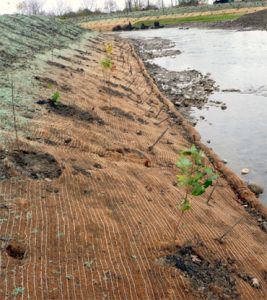- May 11, 2024
- Posted by: wellcoindustries
- Categories: Erosion Control, Jute Mesh
Installing jute netting on a slope is an effective way to prevent soil erosion, support new plant growth, and stabilize the soil in your garden or restoration area. Jute netting, made from natural fibers, is biodegradable and environmentally friendly, making it a preferred choice for many gardeners and landscapers. Here’s a simple guide to help you correctly install jute netting on any sloped area.

Step 1: Prepare the Slope
Before installing the jute netting, it’s important to prepare the area to ensure the netting can provide maximum protection and effectiveness. Start by clearing the slope of any large rocks, debris, or weeds. Smooth out the soil to remove any large lumps or dips. This creates a more uniform surface that will help the jute netting lay flat and secure.
Step 2: Dig a Trench at the Top of the Slope
To anchor the jute netting, dig a small trench (about 6 inches deep and 6 inches wide) along the top edge of the slope. This trench will serve as the initial anchor point for the jute netting, providing stability and preventing the netting from slipping once installed.
Step 3: Roll Out the Jute Netting
Start at the top of the slope, where you’ve dug your trench. Roll out the jute netting across the width of the slope, ensuring that it is evenly spread. The top edge of the netting should lay in the trench you dug. It’s important to roll out the netting smoothly and avoid any folds or creases to maintain even coverage.
Step 4: Secure the Netting in the Trench
Once the netting is laid out to your satisfaction, secure it in the trench. Use landscape pins or staples to hold the netting in place. After securing the netting, backfill the trench with the removed soil and firmly pack it down. This helps to lock the netting into place and prevent movement.
Step 5: Anchor the Netting Along the Slope
Continue securing the jute netting down the slope at intervals of about 3 feet. Use more landscape pins or staples to anchor the netting into the soil, ensuring that it is taut and secure. This step is crucial to keep the netting in place, especially during adverse weather conditions.
Step 6: Overlap Sections if Necessary
If your slope requires more than one width of jute netting, make sure to overlap the edges of the netting by at least 6 inches. This overlap ensures that there are no gaps in the coverage which could lead to erosion under the netting.
Step 7: Water the Netting
Once the netting is securely installed, gently water the area. This helps settle the soil and the netting, reducing initial movement and starting the process of natural soil stabilization.
Step 8: Maintain as Needed
Check the netting periodically, especially after heavy rain or wind, and re-secure any areas that have become loose. Jute netting will naturally degrade over time, so consider this when planning long-term landscaping projects.
